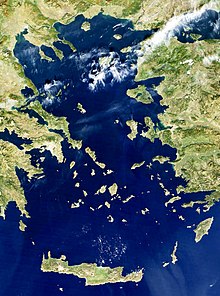Archipelago

An archipelago (/ˌɑːrkɪˈpɛləɡoʊ/ (![]() listen) ARK-ih-PEL-ə-goh), sometimes called an island group or island chain, is a chain, cluster or collection of islands, or sometimes a sea containing a small number of scattered islands.
listen) ARK-ih-PEL-ə-goh), sometimes called an island group or island chain, is a chain, cluster or collection of islands, or sometimes a sea containing a small number of scattered islands.
Indonesia, Andaman and Nicobar Islands, the Galápagos Islands, Japan, the Philippines, Maldives, the Balearic Isles, the Bahamas, the Aegean Islands, Hawaii, the Canary Islands, Malta, the Azores, Canadian Arctic Archipelago, Archipelago Sea (Finland) and the Shetland Islands are all examples of well-known archipelagos.
Etymology[edit]
The word archipelago is derived from the Ancient Greek ἄρχι-(arkhi-, "chief") and πέλαγος (pélagos, "sea") through the Italian arcipelago. In Italian, possibly following a tradition of antiquity, "Archipelago" (from medieval Greek *ἀρχιπέλαγος and Latin archipelagus) was the proper name for the Aegean Sea. Later, usage shifted to refer to the Aegean Islands (since the sea is remarkable for its large number of islands).
Geographic types[edit]
Archipelagos may be found isolated in large amounts of water or neighbouring a large land mass. For example, Scotland has more than 700 islands surrounding its mainland which form an archipelago
Archipelagos are often volcanic, forming along island arcs generated by subduction zones or hotspots, but may also be the result of erosion, deposition, and land elevation. Depending on their geological origin, islands forming archipelagos can be referred to as oceanic islands, continental fragments, and continental islands.[1]
Oceanic islands[edit]
Oceanic islands are mainly of volcanic origin, and widely separated from any adjacent continent. The Hawaiian Islands and Easter Island in the Pacific, and Île Amsterdam in the south Indian Ocean are examples.
Continental fragments[edit]
Continental fragments correspond to land masses that have separated from a continental mass due to tectonic displacement. The Farallon Islands off the coast of California are an example.
Continental archipelagos[edit]
Sets of islands formed close to the coast of a continent are considered continental archipelagos when they form part of the same continental shelf, when those islands are above-water extensions of the shelf. The islands of the Inland passage off the coast of British Columbia and the Canadian Arctic Archipelago are examples.
Further examples[edit]
The largest archipelagic state in the world by area, and by population, is Indonesia.[2]
See also[edit]
- Island arc
- List of landforms
- List of archipelagos by number of islands
- List of archipelagos
- Archipelagic state
- List of islands
References[edit]
- ^ Whittaker R. J. & Fernández-Palacios J. M. (2007) Island Biogeography: Ecology, Evolution, and Conservation. New York, Oxford University Press
- ^ Indonesia. The World Factbook. Washington, DC: Central Intelligence Agency of the United States. 4 December 2008. Archived from the original on 10 December 2008. Retrieved 7 December 2008.
External links[edit]
| Look up archipelago in Wiktionary, the free dictionary. |
| Wikimedia Commons has media related to Archipelagoes. |
- Chisholm, Hugh, ed. (1911). . Encyclopædia Britannica (11th ed.). Cambridge University Press.
- 30 Most Incredible Island Archipelagos


